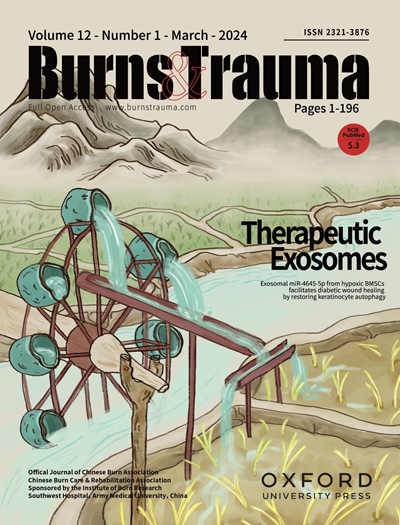Three-Dimensional Composite Aerogel Scaffolds Based on Electrospun Poly(lactic acid)/Gelatin and Silica-Strontium Oxide Short Fibers Promote Bone Defect Healing
IF 9.6
1区 医学
Q1 DERMATOLOGY
引用次数: 0
Abstract
Bone defect regeneration is a dynamic healing process, which relies on intrinsic ability of the body to repair albeit limited healing. The objective of this research was to synthesize hybrid scaffolds based on natural/synthetic polymers and inorganic nanomaterials (NMs). We prepared three-dimensional (3D) composite scaffolds based on flexible silica-strontium oxide (SiO2-SrO) nanofibers and poly(lactic acid)/gelatin (PG) fibers. These scaffolds displayed an ordered porous structure as well as exhibited biocompatibility and biological activity. In vitro release studies demonstrated that the scaffolds enabled sustained and controlled release of silicon ions (Si4+) and strontium ions (Sr2+). Furthermore, these scaffolds not only upregulated the expression of osteogenic-related genes but also promoted tubule-like network formation in human umbilical vein endothelial cells (HUVECs) in vitro. The scaffold enabled concurrent bone regeneration and vascularization in rat skull defect repair. Taken together, our strategy of leveraging the synergistic effect of SiO2-SrO short fibers and PG fibers may have potential to promote bone regeneration and potentially other bio-related disciplines.基于静电纺聚乳酸/明胶和二氧化硅-氧化锶短纤维的三维复合气凝胶支架促进骨缺损愈合
骨缺损再生是一个动态的愈合过程,它依赖于机体固有的修复能力,尽管修复能力有限。本研究的目的是合成基于天然/合成聚合物和无机纳米材料(NMs)的杂化支架。我们制备了基于柔性二氧化硅-氧化锶(SiO2-SrO)纳米纤维和聚乳酸/明胶(PG)纤维的三维(3D)复合支架。这些支架具有有序的多孔结构,具有良好的生物相容性和生物活性。体外释放研究表明,该支架能够实现硅离子(Si4+)和锶离子(Sr2+)的持续和可控释放。此外,这些支架不仅可以上调成骨相关基因的表达,还可以促进体外人脐静脉内皮细胞(HUVECs)小管样网络的形成。该支架在大鼠颅骨缺损修复中实现了骨再生和血管形成的并行。综上所述,我们利用SiO2-SrO短纤维和PG纤维的协同效应的策略可能有潜力促进骨再生和潜在的其他生物相关学科。
本文章由计算机程序翻译,如有差异,请以英文原文为准。
求助全文
约1分钟内获得全文
求助全文
来源期刊

Burns & Trauma
医学-皮肤病学
CiteScore
8.40
自引率
9.40%
发文量
186
审稿时长
6 weeks
期刊介绍:
The first open access journal in the field of burns and trauma injury in the Asia-Pacific region, Burns & Trauma publishes the latest developments in basic, clinical and translational research in the field. With a special focus on prevention, clinical treatment and basic research, the journal welcomes submissions in various aspects of biomaterials, tissue engineering, stem cells, critical care, immunobiology, skin transplantation, and the prevention and regeneration of burns and trauma injuries. With an expert Editorial Board and a team of dedicated scientific editors, the journal enjoys a large readership and is supported by Southwest Hospital, which covers authors'' article processing charges.
 求助内容:
求助内容: 应助结果提醒方式:
应助结果提醒方式:


